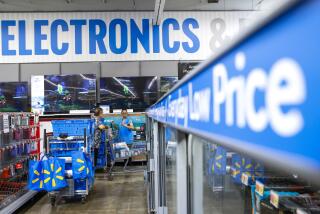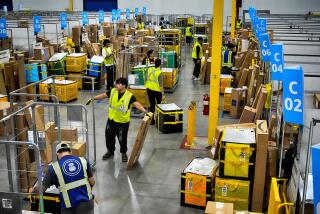GDP shows moderate growth in fourth quarter
Reporting from Washington â The American economy registered moderately stronger growth in the final three months of last year, buoyed by rising exports and the biggest increase in consumer spending in four years, the Commerce Department said Friday.
Economists said the private sectorâs bigger role in driving growth suggests that the 18-month-old recovery will begin this year with stronger momentum, even as the lingering effects of the devastating recession continue to cast a shadow over the economy and especially over employment.
âWhatâs clear from the data is that the economy is recovering and that the recovery is sustainable, but itâs not growing in a way that will create a lot of jobs,â said Mark Vitner, a senior economist at Wells Fargo in Charlotte, N.C.
The Commerce Department said the nationâs gross domestic product â the sum of all goods and services produced inside U.S. borders â expanded at an inflation-adjusted annual rate of 3.2% in the fourth quarter of 2010. That was an improvement over the 2.6% GDP growth in the third quarter.
Ordinarily, 3.2% would be seen as a solid number. But at the current early stage of the recovery, following a recession that eliminated more than 8 million jobs, âitâs subpar,â said California State University economist Sung Won Sohn.
For all of 2010, the U.S. economy grew by 2.9%, returning to the size of its pre-recession level. By contrast, in 1984, after the deep recession of the early â80s, GDP jumped by 7.2%.
Still, economists were heartened by the latest data because they showed a very sharp increase in demand for American-produced goods and services. Whereas government stimulus and companies ramping up depleted inventories propelled the recovery earlier, private-sector spending is now taking the lead.
Consumer spending rose 4.4% in the fourth quarter, about double the pace of the prior three quarters.
The resurgence reflected the best holiday retail sales since 2006 and strong gains in the stock market, which helped bolster confidence and purchases of big-ticket goods that consumers had put off during the recession.
But that heady pace is not likely to last. To support increased consumption, Americans dipped into their savings late last year. The personal saving rate â the percentage of after-tax income that is socked away â dropped to 5.4% in the fourth quarter from 5.9% in the third quarter.
With the housing market remaining depressed and many families trying to cut back after the borrowing binge of the last decade, consumer spending growth is expected to slow down to a rate closer to 3%.
The fourth-quarter GDP would have been much higher were it not for a drag from government and private inventories, both of which had stimulated growth in prior quarters. But the benefits from the federal economic stimulus passed in early 2009 have faded. And companies did not beef up inventories as much in late 2010 as they had before when replenishing after the recession.
The recent drawdown in inventories, however, means businesses probably will have to rebuild their supplies in the coming months. And that will boost GDP in the near term.
Ben Herzon, a senior economist at Macroeconomic Advisers, a St. Louis forecasting firm, is projecting GDP growth of 4% in the first half of this year.
âThat should give the person on the street a little more hope that employment growth will pick up in 2011,â he said.
Last year the economy generated about 95,000 jobs a month, shy of the 125,000 or so needed just to keep pace with the growth in the workforce population. Sohn and some other economists are expecting payrolls to increase on average by about 200,000 a month this year.
Even then, many economists expect the jobless figure to remain close to 9% at year-end. It was 9.4% in December.
Vitner, the Wells Fargo economist, said job growth may lag despite stronger GDP growth. For one thing, he said, improved trade data helped fuel GDP gains in the latest quarter, but most American exports are capital-intensive goods such as jet engines and medical-imagining equipment that require a relatively small number of people to produce.
âWeâre making headway,â said William Dunkelberg, chief economist for the National Federation of Independent Business, a small-business lobbying group. Still, he doesnât see an outpouring of new jobs either.
âThe jobs report should be better,â he said of next Fridayâs release of January employment figures, âbut not better enough to knock down the unemployment rate.â
More to Read
Inside the business of entertainment
The Wide Shot brings you news, analysis and insights on everything from streaming wars to production â and what it all means for the future.
You may occasionally receive promotional content from the Los Angeles Times.











